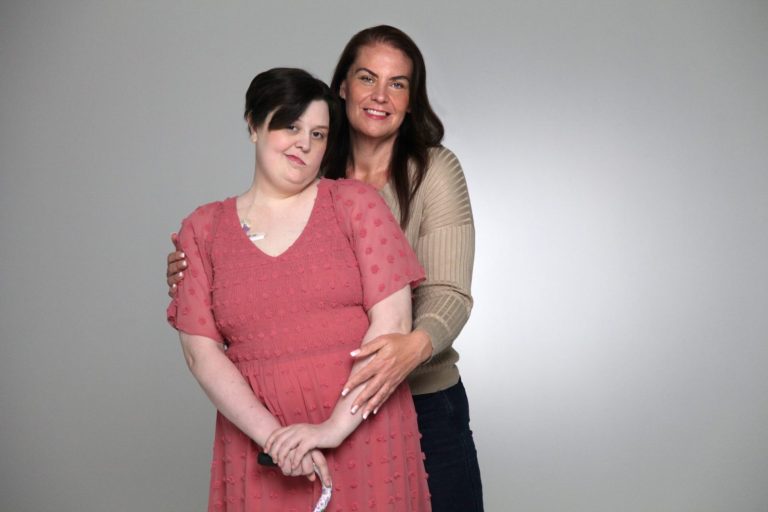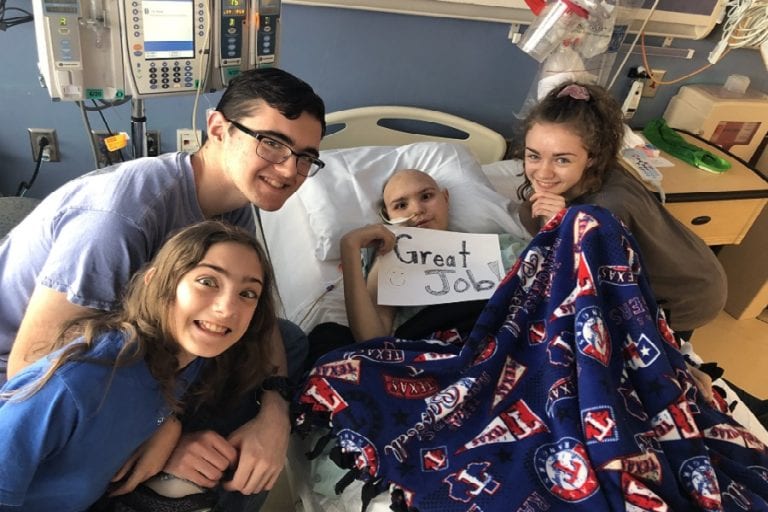Between gymnastics classes and riding bikes around the hospital floor, 4-year-old Brooklyn endures invasive treatments to ensure her leukemia stays wiped out. These treatments leave her prone to infections, which can cause painful rashes and blisters among other side effects. There’s no question that Brooklyn is tough beyond her years.
But, thanks to research funded by supporters like you, scientists discovered methods to potentially reduce painful side effects caused by treatment so severe infections don’t have to be part of childhood.
Since being diagnosed with leukemia in November 2015, Brooklyn’s treatments have become second nature to her: She shows nurses which arm to wrap the big rubber band around when she has blood draws. And, she intimately knows every step of accessing her port to her central line for infusions.
Her intense battle with cancer started when she was 2 years old. Brooklyn wanted to be carried more, often complained of leg pain in between playing and requested to “go right to bed” each evening.
Eventually, her legs ached so much that they began to shake. Her parents knew they had to take her to the pediatrician to perform blood tests and X-rays. The next morning when the doctor called to tell them to pick Brooklyn up from daycare immediately, pack an overnight bag and bring her to the hospital.
Not long after their arrival to the hospital, she was officially diagnosed. “I just cried. I could barely talk,” said Michelle, who was also pregnant with their second child. The threat of early labor due to stress added anxiety to already life-altering news.
Brooklyn began the first stage of treatment, which included many painful spinal taps, bone marrow biopsies and toxic chemotherapies.
Brooklyn gained weight on her small frame fast; lost all movement in her legs due to agonizing pain from the treatment; and she had to relearn to crawl, stand and then walk with physical therapy. Cancer treatment plagued Brooklyn’s body with mouth sores, unbearable muscle pain and tingling in her nerves, which caused her to cry out during diaper changes.
Her parents hoped this initial, brutal phase of treatment would put Brooklyn into remission so she would remain on the standard-risk protocol, the less difficult of two paths. If she didn’t end up in remission, she would move to high-risk and have to endure far more trying therapies.
In December 2015, her first phase of treatment wrapped up. Her family held their breath for the news. The day before Christmas Eve, just over a week after the birth of their son, Thomas, the results came back clear: Brooklyn was in remission.
Or so they were told. The oncologist called to tell them a second review of bone marrow results showed Brooklyn was not in remission after all. “To hear that news was like hearing the diagnosis all over again,” Michelle said. Brooklyn immediately moved up to a high-risk treatment plan with a harsher protocol.
Signing consent forms time and time again is a constant reminder to Grant and Michelle that Brooklyn’s treatment could cause long-term damage to her heart, liver and more— even causing other types of cancer.
Today, Brooklyn is in the maintenance phase and has finally achieved remission. Her family still has a long road ahead, but they hold on to simple moments— like when she plays “doctor” with her stuffed animals, rides her bike or plays with her baby brother.
Supporters like you fund research that’s exploring how to reduce the painful side effects of leukemia treatment for kids like Brooklyn. Today, researchers are studying:
- How to catch leukemia early-on
- How to deliver drugs in a way that reduces painful side effects from treatment
- How to build up a child’s immune system after treatment.
You’re helping make ideas into lifesaving realities.
You can make a difference today.
Share Brooklyn’s story and help build awareness.




